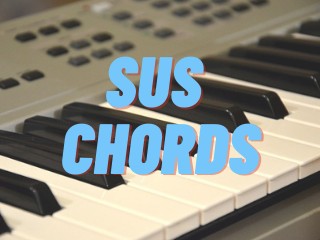 You can find a lot of things to create suspense in life. Such as a good drama at the movies or even today's reality TV. But fortunately, they're not the only entities where you can find a satisfying feeling of suspense. In music, we have sus chords and we're going to go over them in this article.
You can find a lot of things to create suspense in life. Such as a good drama at the movies or even today's reality TV. But fortunately, they're not the only entities where you can find a satisfying feeling of suspense. In music, we have sus chords and we're going to go over them in this article.
What are sus chords? First of all, Sus is short for suspended. A suspended chord is one in which you suspend one note for another. There are two different types of suspended chords so let's take a look at them.
Here's a basic C Major triad which is made up of the root 3rd and 5th. A sus4 chord is a suspended chord in which you suspend the 3rd tone and play the 4th. It is the most common suspended chord and if you see a chord notated as simply "sus" then it's implying the sus4 chord.If you're familiar with the number system, you know the 4th tone of a chord is located a half step up from the 3rd.
A sus4 chord is a suspended chord in which you suspend the 3rd tone and play the 4th. It is the most common suspended chord and if you see a chord notated as simply "sus" then it's implying the sus4 chord.If you're familiar with the number system, you know the 4th tone of a chord is located a half step up from the 3rd. So C sus4 consists of the root, 4th and 5th tones.
So C sus4 consists of the root, 4th and 5th tones.
Play this chord in comparison with the C Major triad. You'll notice that it has a quality of tension that musicians call suspension. It's similar to tossing a ball straight up in the air. After it reaches the maximum height, for a split second it's suspended in mid air until it reverses direction to come back down.
One characteristic of suspended chords is that even though they create tension, they sometimes resolve to a Major chord to release that tension. The simplest example would be from a C sus4 to C Major chord.

Sus chords can go beyond simple triads. They can be added to more advanced chords such as 7th and extended chords.

Sus 2
Even though sus4 chords are the most common of the two types, sus2 chords are also an option for suspension.
A sus2 chord is a suspended chord in which you suspend the 3rd tone and play the 2nd. It's not as common as a sus4 and has a different sound than the sus4 chord because the 2nd is a whole step away from the 3rd unlike the 4th which is a half step away. So C sus2 consists of the root, 2nd and 5th tones.
So C sus2 consists of the root, 2nd and 5th tones.
Like the sus4 chord, the sus2 chord can also resolve back to the Major chord.
 You can also take the sus2 chord beyond simple triads.
You can also take the sus2 chord beyond simple triads.

So what creates this suspended quality by changing just one note? By not having the 3rd present in the chord, it creates an open sound. Also the dissonance between the fourth and fifth or second and root respectively, creates tension.
If you're very familiar with the 12 Major chords, it's an easy step to transition through all 12 sus4 and sus2 chords.
For example, you can start on a sus4 chord and resolve to the Major triad.
 From there, you can move through the circle of 5ths in either direction and play the same chord pattern: F, B flat, E flat, A flat, D flat, etc.
From there, you can move through the circle of 5ths in either direction and play the same chord pattern: F, B flat, E flat, A flat, D flat, etc.
Then cycle through all sus2 chords the same way.

Greg Lee
Latest posts by Greg Lee (see all)
- What is a minor/Major 7 Chord? - October 26, 2023
- 7 Chord Substitutions that Professionals Use - October 19, 2023
- 5 Simple Chord Tricks to Sound Amazing - October 5, 2023



